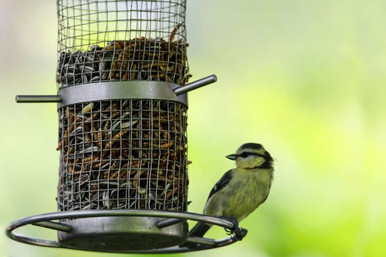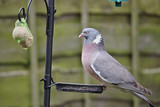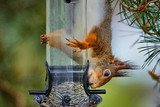Choosing The Right Bird Feed For Your Feeder
Bird feeders provide wild birds with an accessible and reliable food source (providing, of course, the feeder is topped up regularly!) Bird feeders are also an excellent accessory for your yard, garden or allotment, helping nature, encouraging wildlife and allowing you to spot and get to know the wild birds that visit your feeder.
Different types of bird feeders are designed to attract different types of birds and also to hold specific types of bird feed. In this blog, we’ll give you tips on choosing the right bird feed for your feeder.
Bird Feed For Nut Feeders
If you have a peanut bird feeder such as our Ring Pull Click Peanut Feeder or Large Capacity Peanut Feeder, you will want some high-quality peanuts for birds to fill it.
Peanuts are a great source of nutrients for birds. Lots of common garden birds enjoy eating peanuts, such as jays, great tits, blue tits, woodpeckers, wrens and crows. However, if you plan to feed peanuts for birds it’s important to always use the correct type of feeder to limit which birds can access the nuts, otherwise, smaller birds or fledglings may be tempted by the nuts and could choke.
Other garden visitors such as squirrels may also be tempted by peanuts. If this is an issue in your garden, you may want to consider swapping your standard nut feeder to a squirrel proof bird feeder.
Bird Feed for Seed Feeders
Bird seed feeders can be used by a wide variety of wild birds, including sparrows, goldfinches, greenfinches, chaffinches, and tits. Some birds will remain at the feeder whilst feeding, while others will prefer to take the seeds away to a nearby spot in a tree or bush to eat. Our Big Easy Bird Seed Feeder provides built-in perches for visiting birds who want to hang around!
Seed feeders are designed specifically to hold wild bird seed. There are many different types of bird seed, including seed mixes designed to attract specific birds, such as robin bird food or blackbird and thrush bird seed. You can also feed sunflower seeds from a bird seed feeder.
Bird Feed for Robin Feeders
Robins are one of the UK’s most well-loved birds and a common visitor to garden bird feeders. People like to attract robins to their garden because of their beautiful winter bird song and gardeners love robins because they’re great at catching pests like caterpillars!
Robins are ground feeders and so they typically, prefer to eat from the ground or a feeding tray or they will cling to the side of a bird feeder. This makes a robin feeder like the Jacobi Jayne Robin Feeder an ideal feeding solution if you want to attract robins to your garden.
Robins love to eat wild bird seed or sunflower hearts for birds, making these bird foods a perfect choice for your robin feeder.
Bird Feed for Niger Seed Feeders
Niger seed feeders are designed specifically to dispense niger seeds. Also sometimes known as ‘thistle seed’ or ‘nyjer seeds’, these seeds are highly beneficial and nutritious seeds for wild garden birds. They are rich in oil and enjoyed by many types of birds, particularly finches such as goldfinches, bullfinches and greenfinches, as well as linnets and bramblings.
A standard wild bird seed feeder can’t be used with niger seeds as the seeds are simply too small and would fall out! Our niger seed feeders have smaller feeding ports to hold the seed in place ready for visiting birds.

Other Types of Bird Food
Aside from nuts and seeds for birds, there are lots of other types of bird food that can be used loose or with specific bird feeders.
Bird suet or fat balls are a high-energy bird food that can give wild birds a much-needed boost. Wild birds carry a crucial layer of fat beneath their skin to help keep them warm and sustain them through the long winter months. Good quality fat balls or bird suet are loved by all garden birds and can be fed all year round.
Fat ball feeders should be placed at least five feet from the ground and close to a tree trunk or bush. Fresh drinking water should always be available and in warm weather, it is especially important to place your fat ball feeder away from direct sunlight to avoid the bird suet melting or spoiling. For more tips on feeding suet to birds, check out our blog.
Lots of wild birds enjoy live bird food such as mealworms and calciworms. If you put out mealworms, you can expect to see a range of birds visiting your garden, such as blackbirds, starlings, wrens, house sparrows, song thrushes and robins. The best way to feed mealworms is using a specially designed Mealworm Feeder, which is perfect for feeding either dried mealworms or live mealworms to birds. Mealworms can also be sprinkled onto a bird feeder table.
We hope you’ve found this blog on choosing the right bird feed for your feeder helpful. For more bird feeding advice, please visit the Kennedy Wild Bird Food Blog.
Explore Popular Articles
-
8 Easy Ways to Attract Woodpeckers to Your Garden
8th Apr 2024Woodpeckers are among the most interesting birds known for their drumming sound and bright colours.
-
How to Protect Your Bird Feeders from Pigeons ?
28th Mar 2024You must have noticed damaged feeding ports, hanging mechanisms, perches, lids and bottoms. Who coul
-
5 Foolproof Ways to Rat-Proof Your Bird Feeder
18th Mar 2024Building a bird-friendly environment is a delightful endeavour, but it involves the responsibility o




